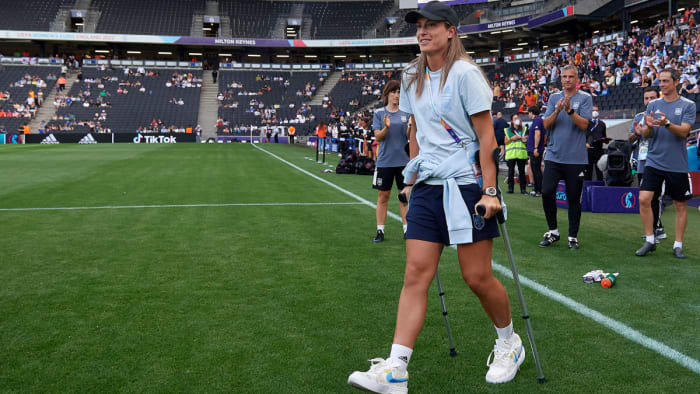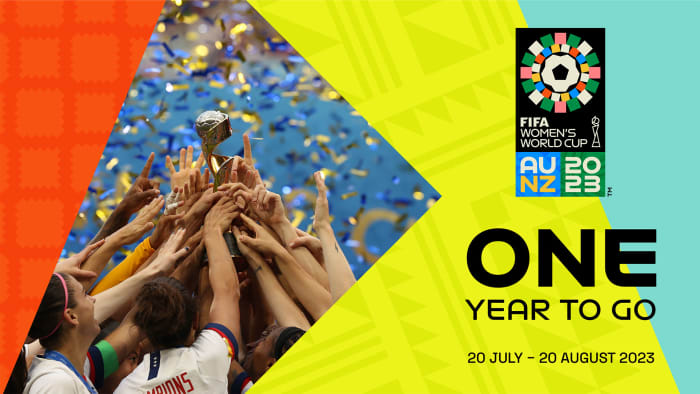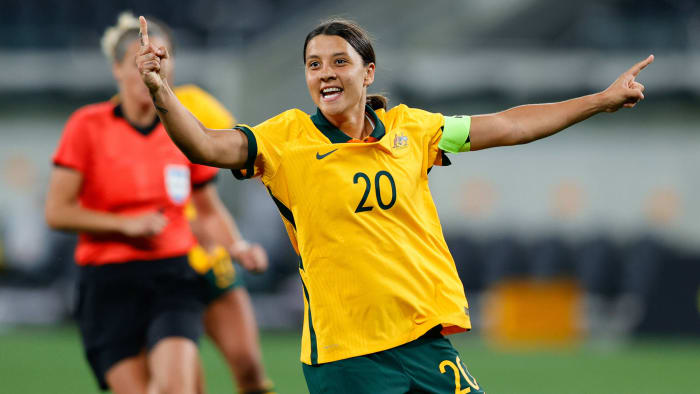One Year Out, Women’s World Cup’s Top Story Lines, Field of 32 Come Into Focus
Wednesday marks exactly one year out from the start of the 2023 Women’s World Cup, which will be cohosted by Australia and New Zealand. It’s the first time the event will be hosted by two countries, with Australia’s matches spread across five cities and six stadiums and New Zealand’s across four cities and stadiums. The Football Ferns and Matildas (who automatically qualify as hosts and will be in different groups) will kick things off with matches on opening day next July, but plenty else remains up in the air.
This year’s field expands from 24 to 32, and with 19 teams already qualified (including the reigning world champs), there are 13 spots still up for grabs. One of those clinched berths belongs to the U.S. women’s national team, which will be going for an unprecedented three-peat and a fifth title overall.
While it will take until February to know the full field (following an intercontinental playoff for the final three berths), the tournament draw will still be held this October. That draw will provide a lot more clarity on the paths each country must take to lift the trophy, but in the meantime, there’s plenty of story lines to follow over the next 12 months that will shape how things play out down under.
The expanded field
The expansion to 32 teams is a huge step forward for the women’s game, matching the 32 the men’s World Cup features (at least until its own expansion to 48 in ’26). One main consequence is it will put more pressure on everyone in the group stage—no longer will a third-place finish still come with the opportunity to advance, and half the field will be eliminated before the round of 16 instead of one-third of it. While the mid- and lower-tier teams will feel the majority of the effects of this change, it also means top-tier teams don’t have the breathing room they once did in the event of a serious early slip-up.
There will likely be growing pains and some lopsided group stage margins both this cycle and next (many likely haven’t forgotten the 13–0 drubbing the U.S. put on Thailand three years ago), but the hope is that the bigger field—plus a prize pool that’s been doubled from 2019’s—will lead to more federations investing in their women’s teams.
Alexia Putellas’s injury
If the 2019 World Cup was Spain’s appetizer as a contender on the big stage, ’23 stands to be its main course—at least, assuming it’s at full strength. That assumption got a lot hazier this month when star midfielder Alexia Putellas tore her ACL and underwent surgery, facing an estimated 10–12 month timeline to return to the pitch. The 28-year-old is the reigning women’s Ballon d’Or and FIFA Best Women’s Player winner, having led the Champions League in scoring last season and spurring Barcelona to its first women’s UCL title in 2021. Alexia is the centerpiece of a skilled Spain team that’s climbed to No. 7 in the FIFA rankings, and entered this month hoping to make good on its promise with a breakthrough Euros performance.
While losing Alexia for the tournament was a brutal blow for Spain, it will be even more devastating for its World Cup chances if she remains sidelined. The good news for the midfielder and La Roja is that she has a full year to rehab, and the team has already qualified for the World Cup. The bad news is that ACL recovery windows can vary, and many players need an adjustment period upon return to get back into their previous form. Coach Jorge Vilda would likely gladly accept any contributions Alexia can give to next summer’s roster, whether as a super sub or a full-fledged starter. But if she’s not at her best, will Spain be?

Alexia was forced to miss the Women’s Euros after tearing her ACL on the eve of the tournament.
Jose Breton/NurPhoto/Imago Images
Is England back?
The last time England was on the World Cup stage, it was going toe-to-toe with the U.S. in a semifinal battle that was arguably the game of the tournament. Given the Lionesses’ young and emerging talent, they seemed poised to only build from there. But that crushing loss unknowingly marked a turning point—the team spiraled under former coach Phil Neville until the pandemic hit, at which point Neville announced he would step down in 2021 and the FA hired breakout Netherlands coach Sarina Wiegman, effective that September. In the interim, Hege Riise coached Team Great Britain at the Olympics, where a group largely made up of England players bowed out in the quarterfinals.
The Wiegman era, though, has gotten off to a flying start, as she appears to have righted the ship just in time as England goes for Euro glory while keeping an eye on 2023. Heading into Wednesday’s quarterfinal with Spain, the Lionesses have gone 15-0-2 under Wiegman, including dazzling margins against the Netherlands (5–1) and Norway (8–0). The country’s first women’s Euros title is no guarantee though, not with the likes of Germany, France, Sweden and others potentially in the way. The favorites have largely cruised so far in the event, a reminder that the continent will send several top contenders down under next year. While England hasn’t yet officially qualified for the World Cup, it’s all but certain to in September.
Can Australia put it together under Gustavsson?
Hosting the World Cup for the first time has to be a dream come true for Australia and New Zealand, but what would make things even sweeter is if they can give the home fans something to cheer about on the field. While the Football Ferns face long odds to make any real waves next summer, the Matildas are an intriguing case. Five years ago Australia was at its highest point in the women’s FIFA rankings (No. 4), and it had put everyone on notice that summer by winning the U.S.–hosted Tournament of Nations. The Matildas looked like a rising force that could challenge for both the World Cup and Olympic gold in the next cycle, but an abrupt coaching change just months out from the former ultimately paved the way for a disappointing exit in 2019.
In response, the federation hired former USWNT assistant Tony Gustavsson as coach, and several players (including world-class striker Sam Kerr) made a pivotal club decision, departing both the NWSL and the W League and signing in England’s WSL. It offered not only a different challenge, but also a playing calendar structure that was less prone to burnout. Despite coming in with lower expectations, Australia fared better at last summer’s Olympics, beating Great Britain and reaching the bronze-medal match, where it fell to the U.S.
Now, the country is at a pivotal phase as many of its key figures hit their prime. Kerr will be 29 next summer, and no one will be keen on wasting what could be her best major tournament yet. Sensing the need to build depth and look toward the future, Gustavsson called in a young and untested roster for two friendlies in June. While it predictably showed in the results (including a 7–0 bludgeoning by Spain), the experience could help down the line. Still, a year isn’t much time, and the regular squad needs to find consistency and some defensive fortitude if it’s to contend for the cup on its home soil.
Will injuries continue to wreak havoc on the landscape?
It’s been a rough year for the health of several standout women’s soccer players. In addition to Alexia, the list of notable ACL tears in 2022 includes Marta (Brazil), Marie-Antoinette Katoto (France) and key U.S. pieces Christen Press, Catarina Macario and Tierna Davidson (the U.S. also lost Lynn Williams to a season-ending leg injury). With the World Cup a year out, we’re now at the point where any major injury will put a player’s status (or at least ability to be 100%) for the tournament into question. And as we move into the fall and winter, one injury could knock someone out of the World Cup picture altogether. The frequency of this year’s high-profile setbacks certainly has many fans on edge wondering who could be next.
The other health factor to keep in mind? COVID-19, which has impacted this month’s women’s Euros (Netherlands’ Vivianne Miedema, Germany’s Lea Schüller and Wiegman are among those who have been sidelined with a positive test) and continues to interrupt domestic leagues like the NWSL. With FIFA approving 26-player roster sizes (up from 23) for this year’s men’s World Cup, it stands to reason the same might end applying for the women.
Right now, we have no idea how prevalent the virus will be in a year’s time—or what regulations the host countries will have regarding entry. While Australia recently halted its COVID-19 vaccination entry requirement for international travelers, New Zealand has not. If that holds through next July, teams will have decisions to make on whether to bring along unvaccinated players who can play in only Australia-based matches (every round through the semifinals contains at least one game in New Zealand). We’ve seen vaccination requirements seriously impact other sports; will women’s soccer be next?
Who’s in, what’s still left to be determined
The 19 nations that have qualified so far will be joined by three South American entrants later this month. Five European nations will join the field in the September international window, and another two will qualify via UEFA playoff in October. That then leaves three final berths, which will be determined in a unique 10-team playoff in New Zealand in February.
Two teams apiece from Asia (Chinese Taipei, Thailand), Africa (Senegal, Cameroon), Concacaf (Panama, Haiti) and South America, and one apiece from Oceania and UEFA make up the field, which is split into two three-team brackets and one four-team bracket. The winners of each advance to the World Cup.
As for the nations in so far, they are (current FIFA ranking in parentheses):
Cohosts: Australia (12), New Zealand (22)
UEFA: Sweden (2), France (3), Spain (7), Denmark (15)
Concacaf: U.S. (1), Canada (6), Costa Rica (37), Jamaica (51)
CAF: Nigeria (39), South Africa (58), Morocco (77), Zambia (103)
AFC: Japan (13), China (16), South Korea (18), Vietnam (32), Philippines (53)
More Soccer Coverage:






